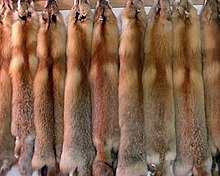Eel line


As Aalstrich , Aalst frost or backbone line of deviating dark, narrow from the rest of staining strip is along the backbone referred to the vertebrates.
General
The eel line takes its name from its shape, which resembles the shape of an eel .
Functionally, it serves to better recognize the contours of light-skinned ( falcon ) species and races and thus social behavior.
The eel line occurs in many farm and domestic animal breeds.
Ridge
The so-called ridge , on the other hand, is not a color difference. The reason for the peculiarity of the coat is that hair follicles are not oriented backwards (dorsal), but to the side (lateral). Inheritance is autosomal dominant: all dogs with an R allele develop a ridge. A ridge occurs in three related breeds of dogs: Rhodesian Ridgeback , Thai Ridgeback, and Phu Quoc Ridgeback . With the Rhodesian Ridgeback there is a connection to the occurrence of dermoid sinus , which corresponds to the dermal sinus in humans . It is a tubular skin opening that can reach the spinal cord and poses a risk of infection. While dogs with the allele combination R / R and R / r cannot be differentiated using the Rigdes, the prevalence for the dermoid sinus is significantly higher in R / R dogs .
Cross stroke
If a backbone line intersects with a shoulder line, the whole thing is called a cross line or cross. This pattern occurs in some donkey breeds, such as the Provencal donkey, it is also interpreted as a sacred symbol. According to legend, the donkeys received this sign of the cross when Jesus entered Jerusalem on a donkey on Palm Sunday.
Grunt
The eel line, including the possibly wider dark back, is referred to as grot on fur .
gallery
Eel line in a dwarf hamster
Eel line in a humped goose
Broad eel line in Skunk
Eel strokes on the Dülmen wild horse
Individual evidence
- ^ Bertelsmann The New Universal Lexicon. Bertelsmann Lexikon Verlag, 2007, ISBN 978-3577102988 , p. 9.
- ^ Jean-Claude Boulet: Dictionnaire Multilingue Du Cheval. Jc Boulet Verlag, 2011, ISBN 978-2981109446 , p. 62.
- ↑ Elaine A. Ostrander , Anatoly Ruvinsky, Jeff Sampson: Genetics of the Dog. CABI Publishing, Wallingford 2012, ISBN 978-1-84593-940-3 , p. 75.
- ↑ Carina Wernig: The psychogram of the crib animals . In: Rheinische Post (NGZ Online). December 24, 2015, accessed December 25, 2015 .




